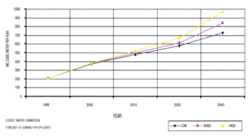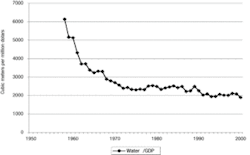Water demand management strategy aims for prosperity with limited water resources
Saul Arlosoroff, the director of the board at Mekorot--Israel National Water Corporation, proposes a comprehensive, integrated strategy to combat water scarcity in arid regions of the world.
By Saul Arlosoroff
Reclaimed water losses and increased efficiency of water use constitute the greatest and most easily accessible water resource in water-scarce countries. Reducing water leaks and preventing water from being wasted in agriculture and industrial sectors could significantly increase available potable water supplies in countries, saving governments millions of dollars required to develop new water resources.
Various governments and international agencies have recently published doomsday forecasts on future water-scarcity and water-related disputes without any insight into the cause of the problem in many countries. They fail to mention that inefficiency of available water supplies is the major culprit of water problems. Irrigation systems account for the main portion of this waste, but this sector is not the only cause.
An effective strategy necessary to increase available water supply is Water Demand Management (WDM), which involves water conservation, and increased water use efficiency. This strategy requires a major paradigm shift from conventional supply management to the management of demand. This shift produces additional quantities of water for the immediate needs of society by creating virtual quantities of water through conservation or by increasing agricultural and industrial production per unit of water. The creation of virtual water can also be improved by adequate government policies that minimize exports of water-intensive agricultural products, while increasing imports of water-intensive products.
Israel’s successful experience in implementing water demand management strategy will be presented in the October/November issue of Water & Wastewater International. This author will also report on the country’s experience in using this effective way to enhance socio-economic prosperity and growth with limited water resources.
Many countries in Asia, Africa, the Middle East, and other regions of the world are suffering from similar or more acute levels of water scarcity. Consequently, international organizations, governments and others are taking actions to gain acceptance of the strategy and concepts of water demand management to decision-makers in countries where the cost of additional supply of water resources have become prohibitive.
Developing countries face far greater water supply shortages and water quality problems than in industrial countries. Rapid population growth in developing countries, particularly in urban areas, are creating great demand for food and agricultural products, which will increase pressures on dwindling water resources. More than 40 percent of food and agricultural products require irrigation. Since most of the economic and accessible water resources in river basins and aquifers are being used, one cannot avoid asking the questions - “From where and how will the demand for more food and water be met?”
Issues of water economics
Not enough water is available to satisfy the needs and desires of everyone in a growing world of already more than six billion people. Inevitably, a growing population must adapt to a world of scarce water resources.
In most cases, water becomes costly to develop and consume when water sources become scarce. The balance between supply and demand becomes distorted when a person, farmer or an industrial facility uses water in an area of limited water resources, by using water that is not available to other consumers. The productive value of water on the farm or industrial facility where it is missing is the “ shadow cost of water,” or the alternative cost of water.
Efficient use of water usually means that the contribution of water to human welfare is the optimum that can be achieved. Its application to agricultural production is considered a contribution to human welfare where people are poor and food supply is not assured. Water must be allocated to satisfy the basic needs of all people in rural and urban areas where water is used for human consumption. This provision of water is considered a basic human right.
Failure to realize that scarcity requires careful allocation of water, and that such allocation is often not assured by “hands-off policies,” is one of the causes of inefficient water use. Another important issue is the failure or absence of political courage to realize that overuse and pollution of water destroys water supply and economic resources, such as aquifers, rivers, soils, lakes, and habitats. The failure to protect the water environment can also be regarded as the destruction of options for future generations. Today’s generation is already suffering the environmental consequences of past failures.
Experience in a number of water scarce countries has taught us that wherever successfully applied, markets and water prices could become highly efficient instruments of appropriate water allocations. They promote water use efficiency and conservation, thus minimizing the impacts and risks associated with water scarcity, and are conducive to socioeconomic growth.
Correct water prices are cornerstones for economic policy in the sector and function mainly in the following ways. Experience shows that the primary role of prices, which is to provide information, is the least understood. The correct price will reflect the cost of water to society; that cost materializes only under scarcity. The product not produced where water is missing is its cost. Shadow prices will thus reflect the cost of the resource.
Farmers, industries and households will use water more efficiently when water prices reflect their economic value. Prices are not intended to encourage people to use less water; their aim is to promote the use of the right quantity of water on the farm, industry, household, and by the urban sector as a whole. Prices, however, also transfer income. Failing to understand the information and allocation role of prices, farmers and urban dwellers usually oppose an adequate price system. Typically, it is viewed as a means of taxation or income transfer. To the contrary, adequate prices encourage efficient use of water. They will increase, not reduce, general income in rural and urban communities, and will reduce the reliance of water users on the whims of the politicians and their servants.
In conclusion, water should be under public control in order to satisfy the basic needs of all members of society, especially in water-scarce, arid regions, where price mechanisms, by themselves, cannot maintain fair and adequate distribution of water resources. This strategy and further investments in water conservation and improved efficiency of use will enable countries to continue advancing socio-economically despite population growth and rising living standards, while opening the door towards solving water conflicts between neighbors.
Author’s Note
Saul Arlosoroff is director of the board and chairman of the finance committee for Mekorot- the Israel National Water Corporation.
References
2.1. S. Arlosoroff - Integrated Water Use Management, World Food Prize, October 2002.
3.2. S. Arlosoroff - UNCHS - Managing Water for African Cities (UNCHS / Nairobi, 1999).
5.3. S. Arlosoroff - Conference on The Improved Efficiency of Urban Resources and Use - UNCHS, Fukuoka, Japan (1998).
4. Prof. Yoav Kislev, Hebrew University/Faculty of Agriculture/Hebrew University-various papers (1990s).
5. Sara Haklai, Mekorot, National Water Corporation. --- PPT Inputs (2002).
Comprehensive, integrated strategy achieves significant water savings
Countries that have achieved successful water demand management campaigns have adopted a comprehensive and integrated approach that includes many of the following components. The author notes that significant conservation can be obtained without following the entire strategy.
- Establish a legal basis for water demand management (WDM);
- Establish adequate institutional responsibility for WDM;
- Apply universal and comprehensive water metering, including its maintenance and calibration;
- Reduction of network losses and unaccounted-for-water;
- Water-saving improvements in irrigation systems, including canal lining, “tail water minimization,” adoption of low pressure irrigation by sprinklers and drip irrigation, and introduction of automated systems;
- Retrofitting urban water systems, including low volume dual flush toilet basins, pressure and/or flow regulation of domestic taps, showers; and automated low-pressure irrigation of parks and gardens.
- Enforced implementation of water conservation methods in industries that consume high volumes of water, including on-site water and wastewater recycling as part of national water pollution prevention policies;
- Urban wastewater treatment and recycling wherever feasible to link treated effluents to nearby irrigation sites and trade this supply for fresh water rights;
- Establish progressive block water rates on the basis of metered supply for THE three main sectors;
- Promote awareness of water conservation by the public and through the educational system. The campaign must also be specifically addressed to politicians and relevant decision makers to emphasize that political courage is necessary to achieve success of this strategy.




